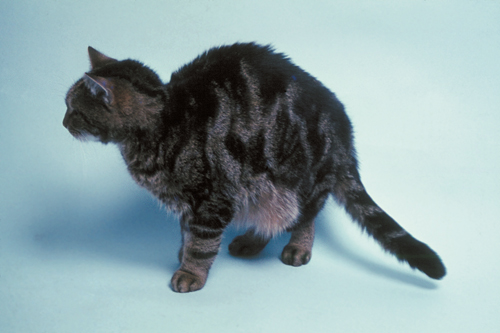
Although it is less common in cats than in dogs lymphedema is a serious medical condition. Fluid Retention and Tissue Swelling Due to Collection of.

Fluid buildup in legs paws andor abdomen.
Peripheral edema cats. Effusionperipheral edema developed within the cats lifetime. Hypoalbuminemia hypercholesterolemia and anemia were defined according to the normal ranges of the reference laboratories where laboratory work was performed. If reference intervals were not availa-ble ie spun PCV was performed rather than complete.
This reaction is referred to as edema swelling. Many issues that cause swelling are harmless to the cat however larger health problems may be found when swelling is present. Swelling can happen in any body part.
To determine the cause of swelling all other symptoms present in the cat must be recorded to help identify any underlying issues. Although it is less common in cats than in dogs lymphedema is a serious medical condition. It is occurs when localized fluid retention and tissue swelling circulates throughout the lymphatic system.
Fluid Retention and Tissue Swelling Due to Collection of. A retrospective study defined FO as development of symptomatic pulmonary edema or pleural effusion in 11 cats with urethral obstruction that were treated with intravenous fluids and compared recorded data from those cats with 51 control cats that had urethral obstruction but did not develop respiratory signs. A FO score was calculated based on the fluid.
Cats may refuse or be unable to walk on the swollen legs and may cry out in pain hiss or growl as a result of using their legs. Other symptoms that often accompany fluid retention in a cats legs include weight loss vomiting increased drinking lethargy fever and diarrhea. Clinical manifestations of right heart failure include jugular venous distention hepatomegaly pleural effusion pericardial effusion ascites and peripheral edema.
Dogs and cats are more likely to develop ascites although right heart failure is uncommon in cats. Horses and cows more commonly develop subcutaneous edema ventrally. In either case cat fluid retention is an indication of a deeper issue that will need to be diagnosed and treated.
Symptoms of Cat Fluid Retention. The first and most visible signs of fluid retention in cats will be the swelling of the face legs and abdominal area. The cat may appear bloated or may appear to have rapidly gained weight.
Signs of primary disease process until chronic when generalized peripheral edema pleuralabdominal effusion weight loss muscle wasting cachexia. Same as primary disease process. Same as primary disease process.
With right-sided congestive heart failure fluid may accumulate in the abdomen or in the limbs known as peripheral edema. Symptoms of heart failure in dogs and cats include. Coughing shortness of breath when at rest laying down.
Coughing or wheezing when playing exercising. Fluid buildup in legs paws andor abdomen. Swelling due to an excessive accumulation of tissue fluid within the interstitium – a small place or gap in the substance of the cats tissues or organs – is referred to as edema.
This can be localized focal or generalized diffuse in location. Dogs and cats with significant hypoxemia should receive oxygen therapy. Positive pressure ventilation is required in several cases.
Methylxanthine bronchodilators may also be beneficial in dogs and cats edema treatment. They are mild diuretics and also decrease bronchospasms and possibly respiratory muscle fatigue. Diuretics are indicated for the treatment of most forms of.
A rat model of sepsis that compared 09 saline with the more balanced crystalloid Plasma-Lyte A for fluid therapy identified worse kidney function in the saline group 83 versus 28. 9 The concentration of chloride in 09 saline solution 154 mEqL is higher than that of plasma in healthy animals average. 110 mEqL dogs 120 mEqL cats and other balanced crystalloids.
Cats with peripheral edema swelling of the limbs may indicate a low protein level in the bloodstream another cause of fluid accumulation. Some cats dont seem to be bothered by ascites while others are clearly uncomfortable. Causes of Pulmonary Edema.
There are lots of possible causes of the pulmonary edema in cats. Some of the more common include the following. An obstruction of the airway.
Too little protein in the blood. Approach to hypoalbuminemia Proceedings August 1 2010. Andrew Mackin BVSc BVMS MVS DVSc DSAM FACVSc DACV.
Albumin is the major determinant of oncotic or colloidal osmotic pressure the force that holds fluids within the vascular compartment. Most of the important osmotically-active particles in the bloodstream such as sodium urea. More severe clinical signs are referred to as nephrotic syndrome and include fluid in the abdominal cavity ascites increased respiratory effort due to fluid within the lungs and swelling of the limbs peripheral edema.
Some cats will demonstrate no clinical signs and the only early evidence of this disease will be an elevated. Fluid therapy in dogs and cats with nephrotic syndrome is difficult to manage because they are prone to developing peripheral edema ascites pleural effusion and pulmonary edema. Monitor physical examination and body weight frequently during fluid administration.
Mardell E J Sparkes A H 2006 Evaluation of a commercial in-house test kit for the semi-quantitative assessment of microalbuminuria in cats. J Feline Med Surg 8 4 269-278 PubMed. Syme H M Markwell P J Pfeiffer D et al 2006 Survival of cats with naturally occurring chronic renal failure is related to severity of proteinuria.
Peripheral edema can occur in both dogs and cats. If the toes are exposed below the bandage check that they are free of discharges or bad smells that they are neither hot nor cold and that they have not become swollen or red.